Two Reasons Why I Love Using Math Journals in Kindergarten
You can use math journals to give students opportunities to write about their thinking and ditch worksheets once and for all. I loved using math journals in my classroom and here’s why.
I hope to highlight two of my favorite reasons why using math journals is awesome with snapshots of student work.
A little background
Here is a little bit of background so you understand why we wanted to start math journals and what we used.
We used math journals in a year-long math journal center.
We started math journaling as a way for students to work through multi-step math work independently (or attempt to anyhow) and for them to explore expressing their thinking in written form using pictures, numbers and sometimes words.
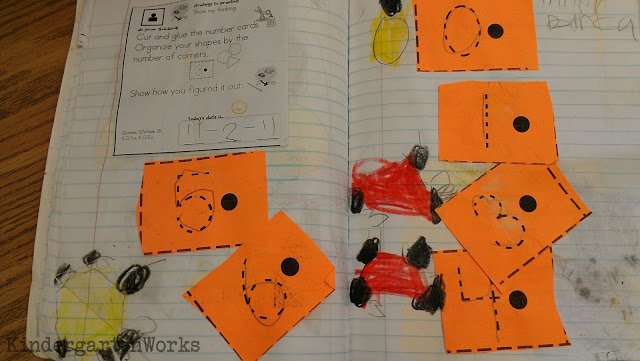
We like to use composition notebooks as our way to keep it all organized.
They sure don’t end up “pretty” by the end of the year… but they are valuable for students to see their growth and for me to remember where we came from.
These have replaced all typical worksheets in my classroom.
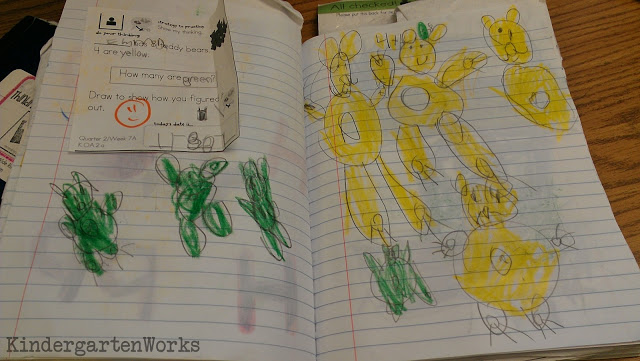
Math journals gave us freedom.
Here’s an example:
As teachers, we broke away from viewing addition and subtraction and using word problems as a “unit” that didn’t normally come until spring.
We can explore various ways to make numbers early on and work on missing addends way before our traditional curriculum ever told us to.
Early exposure and lots of practice helps us grow over the year.
Journaling shows growth
We usually give challenging math prompts in order to show growth and repeat a similar prompt multiple times or later in the year.
[Above] You’ll notice this student was using an equation since they had background knowledge from an older sibling – not typical for November, but I wouldn’t have been able to learn this about this student on the typical worksheet I was previously using.
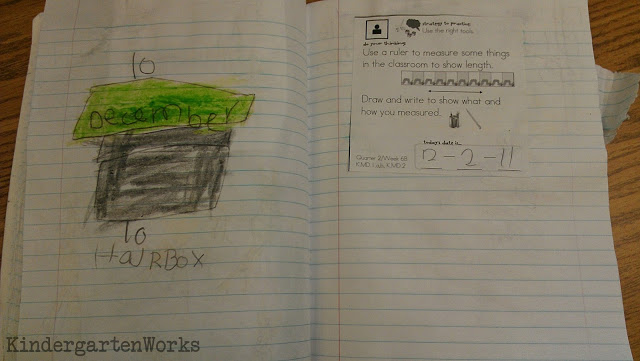
When you use journals, they give students space and opportunity to organize their thinking as it makes sense to them. That’s important.
Now, do all students complete every journal successfully? Um, the answer is a big no.
In fact struggling students do struggle. Following directions, completing multi-steps and practicing the math concept all at the same time does make this more difficult in general.
But then again, you’re not coming to school to do easy. You’re here to learn.
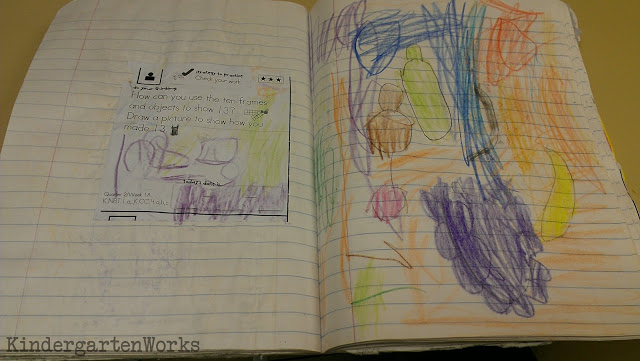
Ahem, here is an example of work that we’ve all seen. Generally, you’ve got someone who didn’t follow directions and totally went off base.
I write notes on work like this before the student reattempts or attempts with more teacher guidance on the next page.
Previously, when we were doing worksheets in class, they were fixing them all with me before they went home.
Parents weren’t seeing the errors and misconceptions.
Now, I have a documentation tool and a communication tool by using this format.
I also “grade” these by writing each student simple feedback before returning them.
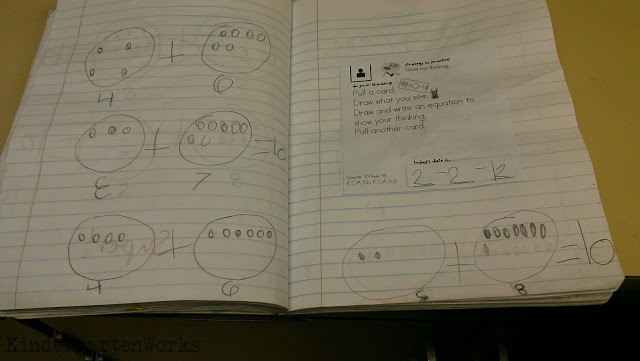
Sometimes (many times) we integrate the use of cards, dice or dominoes to make the journal entries feel fun, interactive and make each unique.
Check out the growth in organizing addition from the teddy bears prompt back in November. It shows how they often begin to organize their work in lines or groupings.
Math journals make it easy to differentiate
Differentiating student work has been a big change for us.
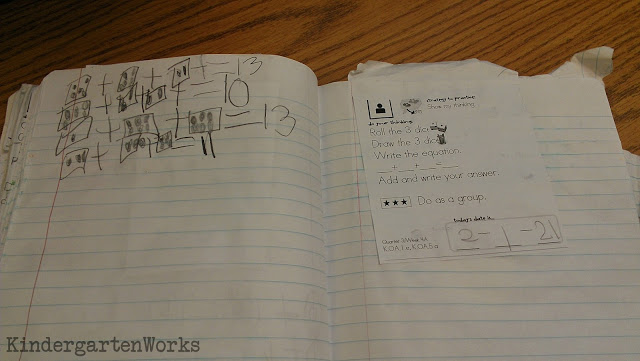
I can alter a journal prompt to match a group’s needs.
Here are a few of my favorite ways of differentiating a math prompt:
- Change the way they do the work
- Change the amount of work expected
- Change the range of numbers they are working with
- Change expectations for how work is shown
I also have the flexibility to create open-ended opportunities for students to show what they know. This allows for instant differentiation – the kiddos do it themselves.
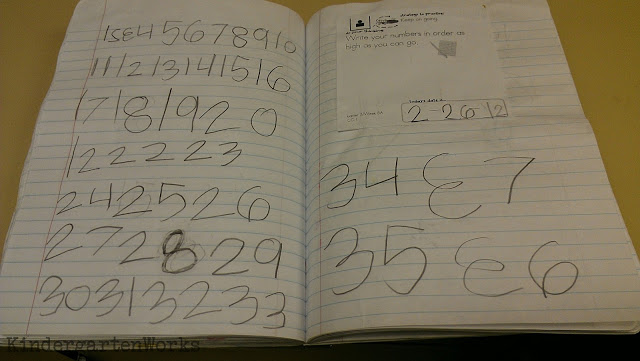
I love that my students could work above grade level easily and with less work on my behalf.
This student is working on decomposing numbers 20+ into groups of tens and ones.
Their group was very comfortable with numbers to 100, working above our grade-level standards. Other groups had cards that focused on 11-19, which was directly aligned with our standards.
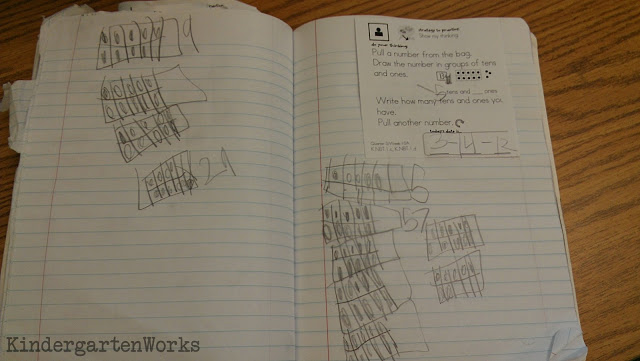
Recap
Now showing growth and differentiation are the two main reasons I love using math journals.
But I’ve learned a few more awesome things about using math journals that I wanted to share:
- You can hit all standards that need repetition
- It’s built-in documentation [notebook provides one easy-to-track location]
- Improved and more sincere communication
- Get and give student feedback
- You can make them open-ended
- Materials to make it “interactive”
- The teacher can better pinpoint misconceptions/errors
- They show growth [built in assessment tool]
- Can give multi-step problems
W share out math journals directly following our guided math time – it is my students’ opportunity to show their thinking, organization, and understanding using spoken words.
If you love the idea of math journals too and want the prompts already done for you – get 74 math journal prompts just for kindergarten in my guided math pack.
If you like what I do here on KindergartenWorks, then be sure to subscribe today. I look forward to sharing ideas with you weekly.

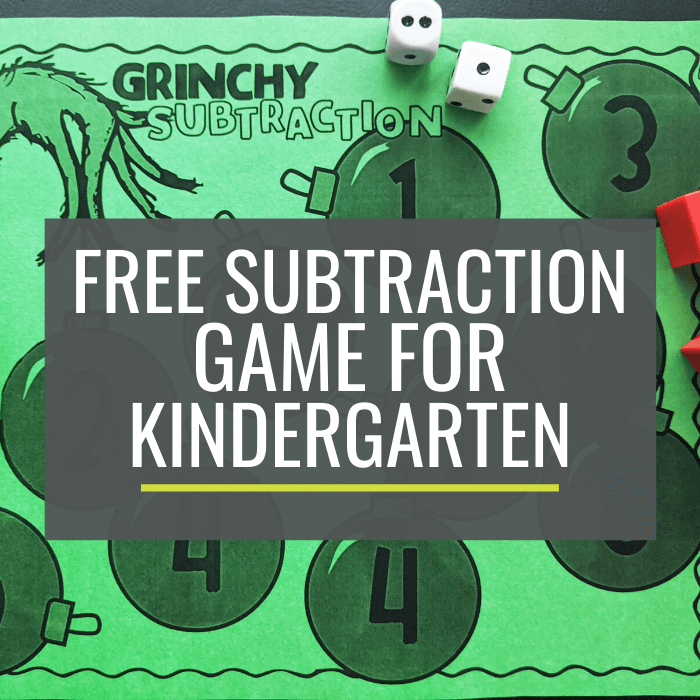

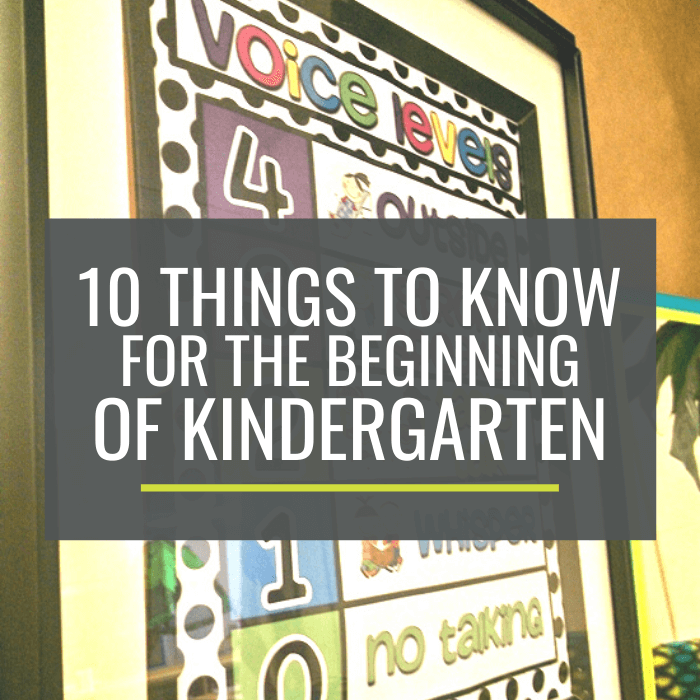
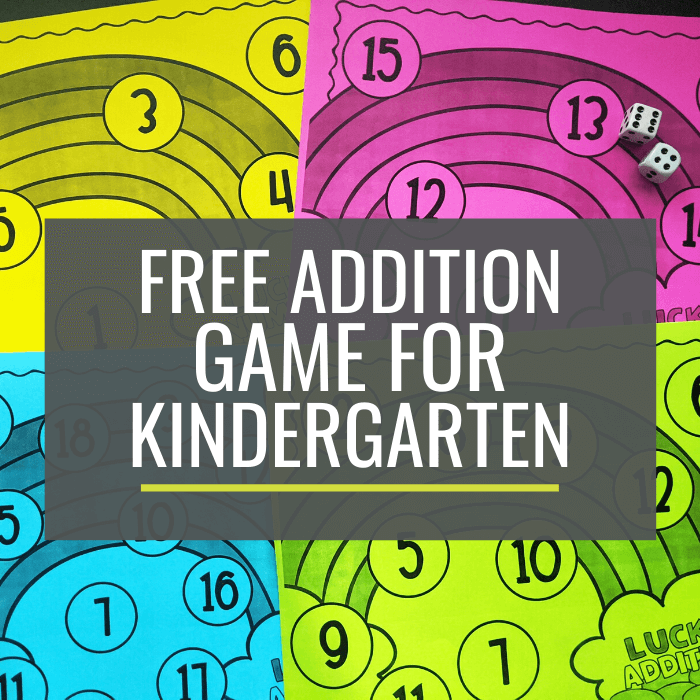

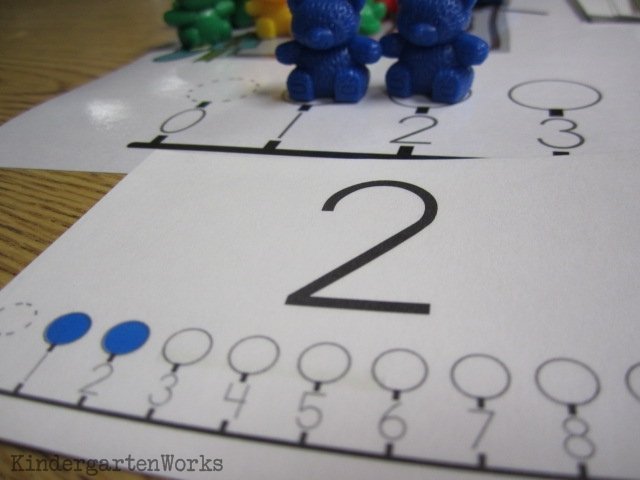
Hi Leslie,
My school is considering using journals for kinder, but is concerned that they might not be developmentally appropriate. I would love to use them. What research could I give them to encourage their use? Thanks!
Hi Mel,
That’s a valid concern. I don’t think that all math journals prompts are created equal and some may not be age appropriate (or really very worthwhile if I’m honest about what’s out there). But if it involves drawing to show thinking, find various ways to solve, show self-growth or practice organizing work – it is definitely appropriate. It backs up the common core standards (see this post: https://www.kindergartenworks.com/guided-math/math-strategies-for-kindergarten/). I don’t have any online resources from others to point to at this time – but if you find something. Do share! My personal opinion is that they are 25x more effective (done right) than a worksheet… which is why my worksheets hid under my classroom sink all year until they were recycled at the end of the year! I did it because it was right for my kinders.
Hi! I love the idea of math journals, but do you read the journal prompt to students daily?
Hi Kari,
I’ve done it multiple ways over the years. Most recently, I did read it aloud for the two days the prompt was in circulation. I did explicit modeling with it the first day, they also saw students share their work afterwards on that first day and then my lowest groups heard it again (with a briefer, lighter modeling) before they completed it on the second day.
One year I started to make videos of the prompt, but that was tricky to follow through with 😉
Thanks,
Leslie
Leslie, I too stumbled upon your work just last week! Love, love, love! After attending a workshop at a conference last year I was ready for a change to how I taught math. This is just what I was looking for! I have used journals for a few years but never felt real connected to the lesson–we too use Saxon. I’m hoping to use your ideas this year and will purchase the first two quarters of prompts. I’m wondering if the quarter 3 & 4 prompts are in the works? Thanks so sharing your work and the virtual encouragement!
Hi Carol, thanks for sharing! Can you send me a personal message on fb or an email – leslie(at)kindergartenworks.com and I can get you a copy of 3 & 4. They are completed but they haven’t been spiffed up for any rightful spot in my shop just yet {wink}.
– Leslie
I have used Math Journals for 4 years now with Kinder. I stumbled over some prompts and have never looked back. At the beginning of the year I will teach the kids how I want it set up and they do it with me in small groups 3-5 days until I am sure they have it. For 3 years they did it as part of morning work. (They come in at staggered times so the early birds could help the later arrivals.) Last year I got a new para at her request she became that station during Math most days. At the beginning of the month I gave the promps that had to be done as well as additional ones and she adapted as needed. Since the prompts were story problems we rocked Math when we officially got to those standards. My stugglers could draw and orally explain their thinking to her and the group. There was alot of kid teaching with support. My other kids tended to solve the initial problem and then go into what if and create their own again kids teaching kids. My AP came in to do observation 1 day. She never made it to my table she sat with the journal group and joined in. As i pointed out because I had para support my kids were getting a double dose of small group Math.
Great beginning tips! Yeah, they do need a lot of support at the beginning. Neat to hear how you’ve done it. Thanks Paula.
– Leslie
Do the students at this zone work on the journals the entire time you are meeting with a group? If they finish before it is time to change to the next zone, what do they do?
Hi Tasha,
Students will work on journals the whole time. I try to model (or modify for specific groups) how they can turn it into an open-ended or multiple solution entry so that way they can continue to work. I also invite students who are faster finishers to make more thorough products and include writing of words to share their thinking.
– Leslie
I need some clarification. I do math journals but have always done them whole group. Well I explain them in whole group, then students complete the journal independently, finally we share our findings with partners or back in whole group. My question is how do you explain and give directions for the journal without wasting your precious time with the students in the teacher zone?
Hi M,
We begin our math time usually with me explaining the journal in full detail (day 1 of the rotation) or reviewing (on day 2). Then we split up into groups and I’m able to stick with my teacher zone. I’ve also done it during a morning activity with just the students going there that day when the rest of the class is working on something completely different and independent. Both ways have worked for me, but we share at the end too and students also see the work of others during that time.
– Leslie
Leslie, just found your website. I am anxious to get started with guided math this year. I love the honest thoughts and great ideas you have contributed about your own journey. Thanks for the wonderful resource! By the way, I am wondering if your journal entries for first and second semester (the newer square entries with prompts) are available for purchase. And am wondering if they are appropriate for kindergarten? Thanks for your commitment to helping all of us learn and grow!
Welcome to KindergartenWorks Lori – glad you found us! Thanks for sharing your thoughts with me as I’m still learning. The journal prompts for the first semester are available for purchase (second is not) and they are designed just for K! You’ll want to look in our guided math pack for the prompts. http://www.teachersnotebook.com/product/KindergartenWorks/guided-math-pack-lesson-plan-templates-strategy-posters-amp-starter-materials
– Leslie
Leslie – Thank You, Thank You, Thank You for this post!!!! I so needed this :). This is my 2nd year teaching Kinder and I feel that I’m still trying to work out the kimks. We use Envisions math curriculum and I would always send the papers home after we finished them. Now that I have 2 kids going up for ESE eligibility – I need to have something to measure in math. This is perfect for me to show growth 🙂
What resource do you use for your math problem of the day for the journals? I see a paper glued into the page of the journal. That looks perfect for each day. Plus It could have the standard right on that page. I’d appreciate any advice.
Thank you again – Joni
Thanks Joni! The paper prompts glued into the journals were created by my favorite teacher down the hall and me 😉 There is a sample download listed at the bottom of this post that you can have for free, plus there are 2 quarters worth in our guided math pack. Thanks for commenting and sharing how you think this idea might help show growth – especially for your 2. Best wishes!
– Leslie
I LOVE using math journals.. I got inspired last year after seeing them used in a kindergarten class at another school. The kids love using them and get so excited about their “special notebooks”. We’ll often use them with word problems, journals prompts, graphic organizers, etc… but I love how you make it more independent by letting them try every step on their own. Nice work! I’ll have to try some of the things you’ve done! 🙂
–Caitlin
thekindergarden.blogspot.com
Caitlin,
It’s great to hear you love using journals and how excited your kiddos get! Thanks for taking the time to shore your thoughts.
– Leslie
You’ve explained this perfectly. This is exactly how I’ve interpreted the use of journals from teaching in England. Thanks for explaining it so well for teachers!
Kelli
Tales From a Traveling Teacher
Kelli,
I appreciate your kind words. Thanks for weighing in on the topic and sharing from abroad!
– Leslie